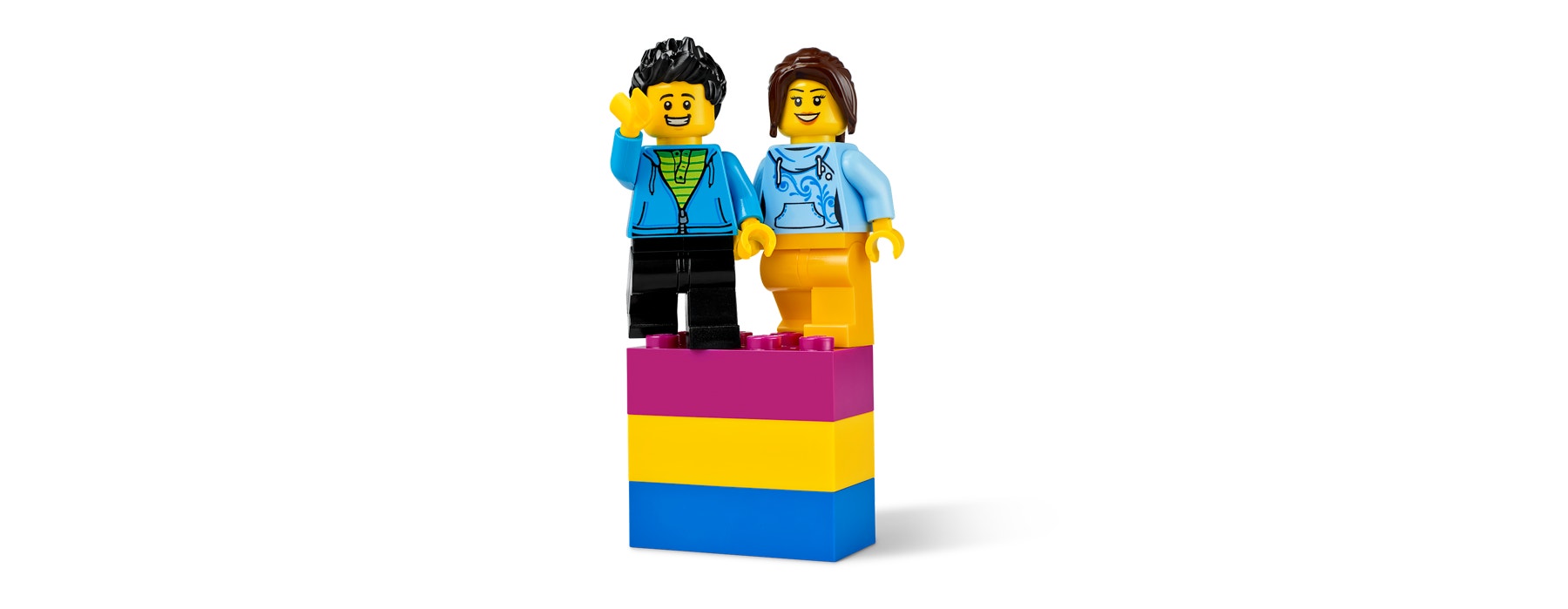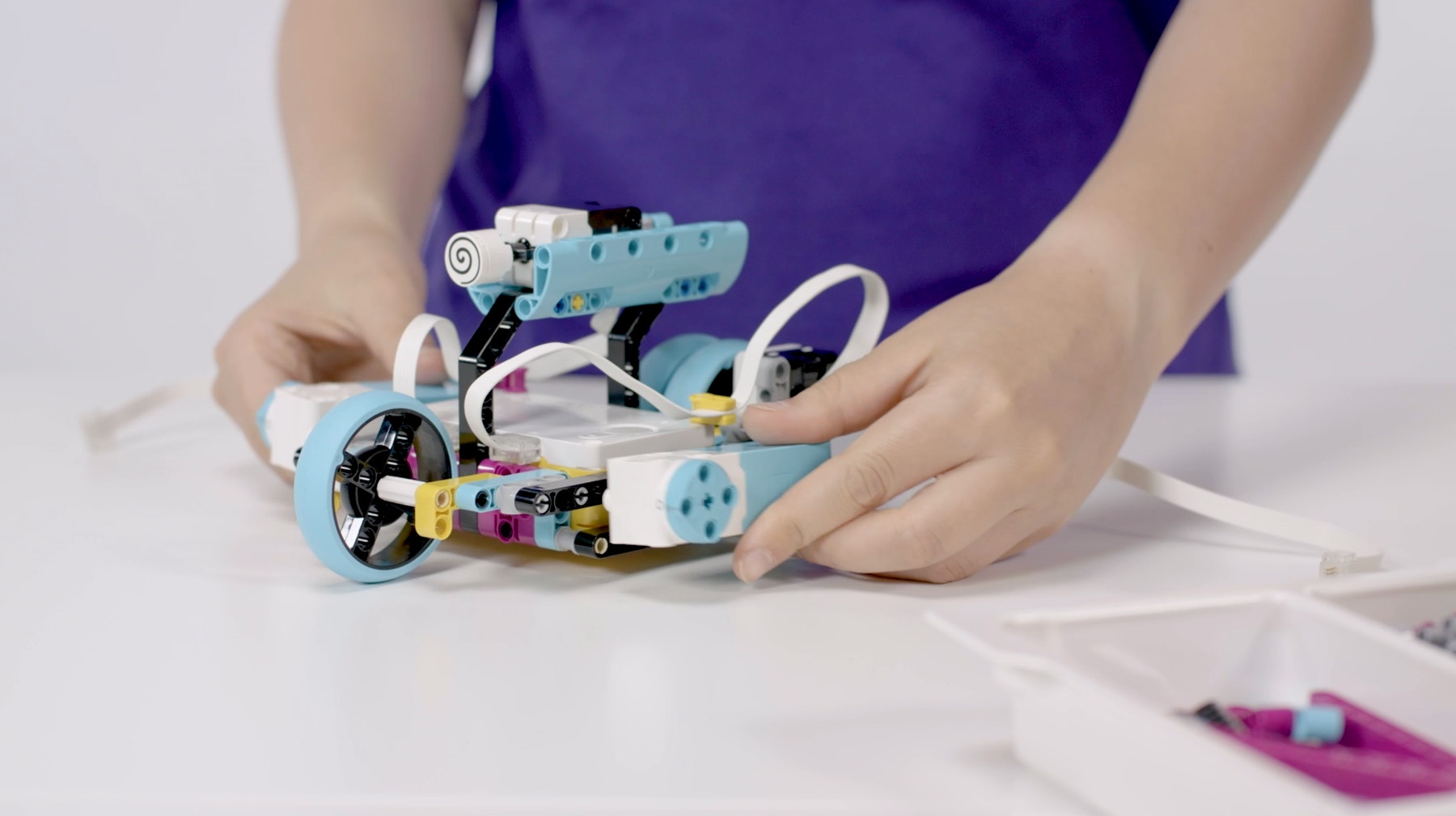Aim for It
Use variable speed to explore kinetic energy during a movement.

Engage
(Before Class, 20 Min.)
- This lesson explores how kinetic energy relates to speed and mass. Your pupils will perform an experiment focusing on measuring the distance that’s been travelled over time. They’ll use wheel rotation as input. Using a graph that shows a wheel’s rotations over time, they'll trace a graph showing the distance that’s been travelled over a period of time, and then try to graph the speed over time. Finally, they'll use the maximum speed value to calculate the kinetic energy using this formula: Ek = ½mv2 m = 305 g
- Use various materials to engage your pupils on the topic of kinetic energy.
Ignite a Discussion
Start a discussion by asking questions related to the lesson. Here are a few suggestions:
- What does the graph showing the distance that was travelled over time look like?
- What does the graph showing the speed over time look like?
- What does the graph showing the kinetic energy over time look like?
Have your pupils write down their thoughts as a hypothesis.
Explore
(During the Lesson, 30 Min.)
- Have your pupils build a vehicle with free-moving wheels. It must also be able to count wheel rotations. They can create their own models or follow the building instructions in the app to build the Street Curling Rock model.
- Ask your pupils to try out their models using the suggested program.
- Have them trace a graph of the distance that’s been travelled over time, and describe what they see:
- What do the spikes in the graph represent?
- Why does the space between the spikes increase as time goes by?
Explain
(During the Lesson, 15 Min.)
- Have your pupils continue the experiment by:
- Converting the rotations per seconds into distance
- Converting the distance that’s been travelled over time into speed
- Allow your pupils some time to adjust their programs to improve their performance.
- Encourage them to record as much data as possible during their experiments.
- Have them export their data as a CSV file so that they can manipulate it using other software if they wish.
Elaborate
(After the Lesson, 20 Min.)
- If your pupils still have access to their SPIKE Prime Sets, have them complete the tasks given in the SPIKE App. This will help them to elaborate on their learning with a bit of hands-on activity. Here are some examples:
- Have your pupils play a game while logging the performance of their throws. Tell them to push their street curling rocks, attempting to have the front of the model stop as close to the centre of the target as is possible. Explain that each pupil or team has 3 goes. They must measure the distance the centre of the target to the front of their model after each attempt. The pupil or team with the smallest cumulative distance after 3 goes wins the game!
- If your pupils don't have access to their sets, have them complete their Inventor Notebooks, or assign one of the extension activities that’s been suggested below. Most of the extension activities can be done using the data that was collected during the hands-on session
- Facilitate a sharing session in which your pupils exchange information. This can be done using whichever method/tool is the most efficient (i.e. in-person or online).
Evaluate
- Give feedback on each pupil's performance.
- To simplify the process, you can use the assessment rubrics that have been provided.
Assessment Opportunities
Teacher Observation Checklist
Establish a scale that suits your needs, for example:
Partially accomplished
Fully accomplished
Overachieved
Use the following success criteria to evaluate your pupils' progress:
- The pupils are able to program a device that logs data on a line graph.
- The pupils are able to interpret the values coming from the line graph.
- The pupils can explain kinetic energy in relation to speed.
Self-Assessment
Have each pupil choose the brick that they feel best represents their performance.
- Blue: I’m able to graph data using the program that’s been provided in the app.
- Yellow: I’m able to create my own line graph and explain my results.
- Violet: I've created new experiments on my own.
Peer Feedback
Encourage your pupils to provide feedback to one another by:
Having one pupil use the coloured brick scale above to score another pupil’s performance.
Asking them to present constructive feedback to one another so that they can improve their group’s performance during the next lesson. This is an excellent opportunity to use videoconferencing tools or blog posting tools in a blended learning scenario.

Differentiation
Simplify this lesson by:
- Limiting the lesson's focus to variations in the distance that’s been travelled over time
Take this lesson to the next level by:
- Asking your pupils to design and build their own freewheeling vehicles and curling rocks, repeat the experiment and compare their data to another model’s performance (e.g. a classmate’s model)
- Having your pupils design and build their own pushing devices that can provide more regular throws, and document the design process

Tips
Building Tips

Coding Tips
This lesson is designed to be played while the hub is connected through USB or Bluetooth. While connected, the data collected by the Hub is streamed directly to your device, and traced in real-time on the Line Graph.
Main Program

Solution Program

Science Data Tips
Here’s an example of the data your pupils can expect from this experiment.

Extensions
Maths Extension
To incorporate the development of maths skills:
- Have your pupils explore what happens when they change their curling rock's mass by adding elements (e.g. motors) or a heavy object (e.g. a water bottle). Ask them to update their models, rerun the experiment and compare the graphs showing the speed over time for the different masses.
Note: This will require additional time.

Literacy Extension
To incorporate the development of literacy skills:
- Ask your pupils to create a marketing campaign promoting the key features of their models. Tell them to include the model's technical characteristics and use scientific facts related to the concepts of speed and energy to highlight their benefits.
Note: This will require additional time.

Career Links
The pupils who enjoyed this lesson might be interested in exploring these career pathways:
- Education & Training
- Health Science
Teacher Support
Pupils will:
- Calculate the initial speed for a decelerating movement from a graph showing the distance that’s been travelled over time
- Use this approximated speed to calculate the average kinetic energy
LEGO® Education SPIKE™ Prime Set
Device with the LEGO Education SPIKE App installed
DFE Science Programmes of Study KS3
Experimental skills and investigations - 3
•tselect, plan and carry out the most appropriate types of scientific enquiries to test predictions, including identifying independent, dependent and control variables, where appropriate
Experimental skills and investigations - 5
•tmake and record observations and measurements using a range of methods for different investigations; and evaluate the reliability of methods and suggest possible improvements
Changes in systems - 1
•tenergy as a quantity that can be quantified and calculated; the total energy has the same value before and after a change
Changes in systems - 3
•tusing physical processes and mechanisms, rather than energy, to explain the intermediate steps that bring about such changes.
DFE Maths Programmes of Study KS3
Reason mathematically - 1
•textend and formalise their knowledge of ratio and proportion in working with measures and geometry, and in formulating proportional relations algebraically
Ratio, proportion and rates of change - 7
•trelate the language of ratios and the associated calculations to the arithmetic of fractions and to linear functions
Ratio, proportion and rates of change - 8
•tsolve problems involving percentage change, including: percentage increase, decrease and original value problems and simple interest in financial mathematics
Ratio, proportion and rates of change - 9
•tsolve problems involving direct and inverse proportion, including graphical and algebraic representations
DFE English Programmes of Study KS3
Writing - 1
Pupils should be taught to:
•twrite accurately, fluently, effectively and at length for pleasure and information through:
•twriting for a wide range of purposes and audiences, including:
•tsummarising and organising material, and supporting ideas and arguments with any necessary factual detail
DFE Computing Programmes of Study KS3
Subject Content – 1
•tdesign, use and evaluate computational abstractions that model the state and behaviour of real-world problems and physical systems
Subject Content – 3
•tuse two or more programming languages, at least one of which is textual, to solve a variety of computational problems; make appropriate use of data structures [for example, lists, tables or arrays];
Subject Content – 7
•tundertake creative projects that involve selecting, using, and combining multiple applications, preferably across a range of devices, to achieve challenging goals, including collecting and analysing data and meeting the needs of known users
Subject Content – 8
•tcreate, re-use, revise and re-purpose digital artefacts for a given audience, with attention to trustworthiness, design and usability
DFE Design & Tecnology Programmes of Study KS3
Design - 1
•tuse research and exploration, such as the study of different cultures, to identify and understand user needs
Design - 2
•tidentify and solve their own design problems and understand how to reformulate problems given to them
Design – 3
•tdevelop specifications to inform the design of innovative, functional, appealing products that respond to needs in a variety of situations
Design – 4
•tuse a variety of approaches [for example, biomimicry and user-centred design], to generate creative ideas and avoid stereotypical responses
Design – 5
•tdevelop and communicate design ideas using annotated sketches, detailed plans, 3-D and mathematical modelling, oral and digital presentations and computer-based tools
Evaluate - 3
•ttest, evaluate and refine their ideas and products against a specification, taking into account the views of intended users and other interested groups
Technical Knowledge - 4
•tapply computing and use electronics to embed intelligence in products that respond to inputs [for example, sensors], and control outputs [for example, actuators], using programmable components [for example, microcontrollers].




